
Green, Social, Sustainability and Sustainability-Linked (GSSS) Bonds could play a key role in helping developing countries fund progress towards the sustainable development goals (SDGs) and a Just Transition to Net-Zero.
The market has grown exponentially since its inception, to reach $3.8 trillion at the end of 2022, and could help fill the growing financing gap. Use-of-proceed bonds ensure that issuers allocate the proceeds towards impact, while newer but fast-growing Sustainability-Linked Bonds go a step further by encouraging issuers to develop holistic sustainability strategies and increasing transparency. GSSS bonds could help mobilise capital at scale and reduce the cost of capital for SDG-related projects, but issuance in developing markets only makes up 15% of the global GSSS bonds market. To harness their full potential, it is essential to build a track record to demonstrate feasibility, derisk investments to make opportunities in developing markets viable for commercial investors, improve issuer capacity, develop bankable project pipelines, reduce the cost of bond issuance, address impact washing concerns, and harmonise standards.

$3.8 trillion
is the size of the GSSS bond market

$4 trillion
is the size of the annual SDG financing gap

15%
share of bonds issued in developing countries
This paper identifies recommendations on how issuers, private sector investors, policymakers, and development finance institutions (DFIs) can support the growth of GSSS bond markets in developing countries.









